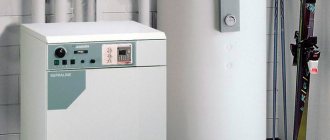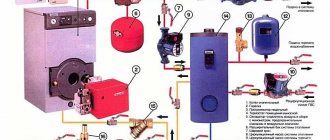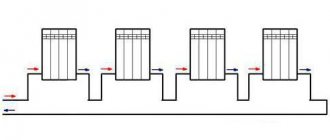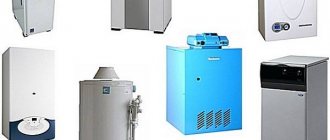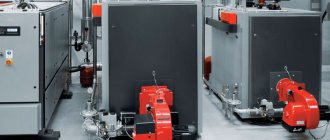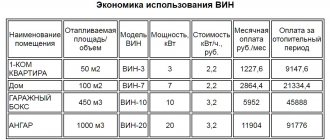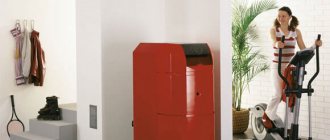Boiler ION
Only electrode heating boilers are produced under the ION brand. There is an important distinctive feature of the company. They do not claim that their boilers are 30-40% more economical than heating elements, taking into account that both operate with an efficiency close to 100%.
For ION boilers, the coolant requirements have been slightly changed. The best results are achieved with a conductivity of at least 3 kOhm/cm, which is achieved by a higher salt concentration in the solution. But in return, the manufacturer guarantees the durability of the electrode for up to 30 years, which is several times higher than the durability of the main element from Galan and several orders of magnitude higher than the durability of homemade steel electrodes.
There is no division of boilers into lines with characteristic names. The manufacturer claims to have boilers with a capacity from 2 kW to 36 kW. Devices from 2 to 12 kW can be connected to a single-phase 220V network, and boilers from 6 kW to 36 kW are made for three-phase 380V power.
| Technical data | unit. | Heating device "ION" | |||||||||
| Power | kW | 2 | 3 | 4 | 5 | 6 | 7 | 8 | 9 | 10 | 12 |
| Voltage | volt | 220 ~ ± 10% | |||||||||
| Type of current | single-phase, alternating | ||||||||||
| Voltage frequency | Hz | 50 | |||||||||
| Heated room volume | m³ no more | 120 | 180 | 240 | 300 | 360 | 420 | 480 | 540 | 600 | 750 |
| Heated area | m² no more | 40 | 60 | 80 | 100 | 120 | 140 | 160 | 180 | 200 | 250 |
| Coolant volume in the heating system | liters, no more | 80 | 120 | 160 | 200 | 240 | 280 | 320 | 360 | 400 | 480 |
| Coolant | water | specific resistance of the coolant at a temperature of +15 C ° is not less than 1000 Ohm x cm. | |||||||||
| Hot water lift height | meters, up to | 3 | 4 | 5 | 6 | 7 | 8 | 9 | 10 | 11 | 13 |
| Efficiency | %. before | 99 | |||||||||
| Outlet temperature | C°. before | 95 | |||||||||
| Operating pressure | mPa | 0,2 |
| Technical data | unit. | Heating device "ION" | |||||||||
| Power | kW | 6 | 9 | 12 | 15 | 18 | 21 | 24 | 27 | 30 | 36 |
| Voltage | volt | 220/380 ~ ± 10% | |||||||||
| Type of current | single-phase, three-phase, alternating | ||||||||||
| Voltage frequency | Hz | 50 | |||||||||
| Heated room volume | m³ no more | 360 | 540 | 750 | 900 | 1080 | 1260 | 1440 | 1620 | 1800 | 2250 |
| Heated area | m² no more | 120 | 180 | 250 | 300 | 360 | 420 | 480 | 540 | 600 | 750 |
| Coolant volume in the heating system | liters, no more | 240 | 360 | 480 | 600 | 720 | 840 | 960 | 1080 | 1200 | 1440 |
| Coolant | water | specific resistance of the coolant at a temperature of +15 C ° is not less than 1000 Ohm x cm. | |||||||||
| Hot water lift height | meters, up to | 6 | 9 | 12 | 15 | 18 | 20 | 20 | 22 | 22 | 24 |
| Efficiency | %. before | 98 | |||||||||
| Outlet temperature | C°. before | 95 | |||||||||
| Operating pressure | mPa | 0,2 |
Especially for heating systems that include aluminum radiators, it is proposed to use the drug ASO-1, which can increase the conductivity of the coolant and eliminate the consequences associated with aluminum, especially recycling.
Installation of an ion heater
Do-it-yourself electrode heating boilers are assembled taking into account the remaining heating elements. To do this, you should develop a sequence of actions and install the devices one by one. The boiler is not installed separately, but integrated into the system.
You should prepare the materials and install the heater sequentially
Work order:
- Determine the type of heating circuit - single-circuit or double-circuit, with water heating for household needs. Select and install suitable radiators.
- The boiler is assembled and connected to the main line.
- Observe the operation of the device in test mode. Make sure that the device’s characteristics are maintained at the required level.
- Automate the operation of the boiler.
It is necessary to adhere to this sequence of work. The heating device does not need to be assembled first, since it will not be possible to test the operation of the coolant line. They begin work by creating drawings of an electrode boiler with their own hands.
The procedure for assembling an electrode boiler:
- A coupling is screwed onto the steel pipe, which will act as the body of the device, on one side, and a tee on the other. Tighten tightly to prevent further coolant leaks. Through the tee, liquid will flow from the boiler into the system, and vice versa.
- An electrode is inserted into the body from the end of the tee. It is important to prevent contact between it and the body. Secure the electrode with a plug from the radiator. He must stand still. To do this, fixation is performed with a nut. The insulator also plays a sealing role. If there is no suitable material, then it is better to turn to professionals to make the part.
- Pour some liquid into the assembled housing and check the reliability of the connections. There should be no leaks. If any, the seals are adjusted. If there are no leaks, then the water is poured out.
- 2 steel bolts are welded to the boiler body. The optimal choice is M8 and M10. They are needed to connect wires - grounding and neutral. The nuts should be covered with an insulator to avoid electric shock during operation.
- The device is installed in the heating system.
This is important: standards and requirements for installing heating boilers in a private home.
Additional equipment is required for safe operation and cannot be ignored.
For safety reasons, the boiler is equipped with additional elements. During operation, electrolysis gas is released from the liquid, so it should be removed from the system. For this you will need:
- air removal valves, automatic;
- safety valve;
- a pressure gauge that will allow you to control the power of the device;
- expansion tank;
- shut-off valves.
The devices prevent a critical increase in pressure in the system. The gas will gradually come out.
Review and prices for the best brands of electrode boilers
Currently, several manufacturers of electrode heating devices are the most popular.
Galan
Products of the domestic production enterprise "Galan" are in demand not only in the Russian Federation, but throughout the CIS. Reliable and economical units “Geyser”, “Vulcan” and “Ochag” are distinguished by compact overall dimensions, long service life and attractive body design. For heating a private home, the “Ochag - 6” modification is most often used, which has the following technical characteristics:
- Starting current – 15 A;
- Rated power of the installation – 6 kW;
- Weight without coolant – 1.7 kg;
- Case height – 320 mm.
The advantages of an electrode boiler include affordable cost, ease of installation and maintenance. For effective long-term operation, it is advisable to install a voltage stabilizer and use special liquids as a coolant.
The price of the unit is 4500 rubles.
EOU
The Ukrainian company offers electrode boilers, the body of which is made of seamless steel pipe with a wall thickness of 4–5 mm. The model range consists of heaters with a power from 2 to 12 kW, operating from a household electrical network and three-phase models with a power of up to 125 kW. The greatest demand is for devices generating from 3 to 6 kW. Specifications:
- Rated power 3–6 kW;
- Maximum heated area – 120 m2;
- Body cylinder length – 185 mm;
- Weight – 7 kg.
The delivery set includes a control system and a circulation pump. The price of an electrode boiler is 7,500 rubles.
Beryl
Products from this Russian brand automatically take into account the state of the electrolyte in the heating circuit and adjust the operating mode of the installation. Like many other manufacturers, the company produces devices for a single-phase electrical network with a rated power of 2 to 10 kW and for a three-phase network, designed for 35 kW. Reviews from buyers of electrode devices indicate that the most popular model is “Beril - 9”, which has the following technical characteristics:
- Installation power – 9 kW;
- Connection – three-phase;
- The maximum heated area is 250 m2.
The product is easily installed in the heating circuit, and the control system provides the ability to adjust the power in the range from 2 to 9 kW. The average price of the unit is 8,500 rubles.
Protherm Skat 24 KR 13
The electrode boiler has proven itself to be a safe, reliable and efficient device. The installation power is 24 kW, the basic configuration includes a 7-liter expansion tank and a circulation pump. The obvious advantages of the boiler include:
- Wide temperature range (can be adjusted from 30 to 85 C);
- The product is equipped with safety systems against overheating and soft start;
- Four-stage power adjustment is provided.
The minimum price of the unit is 43 thousand rubles.
Below are reviews from owners of electrode systems who have assessed in practice the advantages and disadvantages of such systems.
Advantages and disadvantages of electrode heating boilers
We will compare electrode models only with other electric water heaters. Gas boilers will not be taken into account, which, of course, are much cheaper to operate, but require obtaining permits for their use, the availability of a project, gas and other special conditions.
So, ion boilers can stand out among their analogues in the following ways:
Electrode boilers are the smallest heating elements. Which does not affect their performance at all.
- they are compact, have a simple design, so they are well suited for use in dachas or private homes;
- the devices are not afraid of voltage surges, since the latter only affects the power of the boiler, but not its operation;
- ion water heaters quickly heat up and cool down, so it is convenient to use any automated room temperature control systems with them;
- they are safe, since even in the absence of water the device will not deteriorate, will not cause a fire or short circuit , it simply will not work (there will be no closed circuit);
- they have excellent efficiency, reaching 98%.
Disadvantages of electrode water heaters:
- knowledge in electrical engineering is needed not only to build a boiler, but also to calculate the parameters of the liquid, its electrical conductivity and the amount of impurities;
- Ordinary water, for example, from any heating system, is not suitable for operating the device, since such a liquid contains many free ions;
- air should not be allowed to enter the boiler, as this will accelerate the process of metal corrosion, thereby reducing the service life of the water heater;
- you need to monitor the temperature of the water in the boiler, since if it exceeds 75 degrees, this will significantly increase energy costs;
- when installing the device, it must be grounded, especially for homemade devices;
- The power of the water heater directly depends on the coolant ; high-quality and correctly made liquid can increase the power of the device and vice versa;
- they operate on AC power only.
You can use your electrode boiler as an instantaneous water heater by simply connecting it to the water supply system.
In addition, it is worth mentioning several features of the ion water heater:
- it can be used as a regular instantaneous water heater, and not just as a boiler;
- ease of assembly and installation, ease of repair have a positive effect on its popularity;
- very cheap, even if you buy a factory version rather than making it yourself;
- silent, has no impact on the environment or humans, does not emit toxins or harmful substances, so it can be installed anywhere.
No matter how good an ion boiler is, it is still not a worthy replacement for gas analogues. If it is possible to install gas equipment, of course, choose the latter.
Design features
The thermal fluid used is heated during the movement of multidirectionally charged ions between the electrode contacts. The design of such a heater is quite simple. It consists of: a metal rod and a hollow steel pipe.
The device is hermetically sealed on both sides. Special pipes are welded to its sides. With their help, the heater is connected to the heating system.
The phase wire is attached to the inner rod, and the neutral wire is attached to the surface of the housing. A three-phase network is used to power powerful heat generators.
Electrode (ion) type Galan boiler
Under the influence of alternating current, the ions contained in the thermal fluid constantly change the direction of their movement. Electrolysis is not carried out fully. During the heating process, there is no transfer of substance between the two electrodes.
The heating device has the following characteristic features:
- small overall size;
- simple design;
- ease of installation;
- high level of efficiency;
- long service life;
- reliability of operation - there are no contacting parts;
- low cost.
Advantages
Electrode heating boilers make it possible to regulate the indoor microclimate and save electrical energy. If we compare their efficiency with the efficiency of induction devices and heaters, which include heating elements, we should note the advantages of the electrode design:
- the water entering the boiler is heated very quickly;
- efficiency level approaches 100%;
- long service life. The design features of the device cause rapidly changing polarity. Ions constantly change the direction of their movement. Therefore, despite the presence of constant contact of the surface of the electrodes with the liquid, scale does not form on them;
- the electric electrode boiler has small dimensions;
- it is easy to install in any room;
- there is automatic control of the operation of the heating device;
- The heater has a high level of fire safety. If the system depressurizes, the risk of electric shock is eliminated. The device will simply stop working;
- there are no extraneous noises during operation of the heating system;
- electrode electric boilers for heating a private home do not have a harmful effect on the environment;
- chimneys are not used during their operation;
- devices are not afraid of voltage surges
Flaws
Despite the high quality performance of electrode heating systems, certain disadvantages should be taken into account:
- for high-quality functioning of the heater, pre-prepared water is required, which has a given resistivity;
- Distilled water, antifreeze or oil cannot be used as a heat carrier;
- An electrode electric boiler for heating can operate effectively only with continuous circulation of liquid. If the movement speed decreases, the likelihood of the system boiling increases. If it increases, difficulties may arise with starting the heating unit;
- Over time, the substance that makes up the electrodes dissolves in water. They have to be replaced periodically;
- the heating system must have a grounding circuit;
- when the temperature of the coolant increases above 75 degrees, the consumption of electrical energy increases sharply;
- in single-circuit devices, the liquid cannot be used for domestic needs.
Advantages of an ion boiler
The primary advantages of using an ion boiler
To install an ion (electrode) boiler, you do not need to give up the use of gas connected to your home. The main thing is the presence of wiring from radiators and highways. It is worth noting that electrode boilers, as a rule, play the role of secondary devices in the house. If the cost of the gas tariff shows an increase in indicators, then it is recommended to use the ionic system as the primary source of heating the room.
Let's consider the positive characteristics of an ion electrode heating boiler:
- Reliability, or fire safety;
- Quiet operation;
- No need for a separate room to install the device – compactness;
- The presence of combustion products is not provided - an environmentally friendly operating principle;
- Autonomy of room heating;
- No complex manipulations during the system installation process;
- High degree of efficiency;
- Efficiency rates up to 99 percent;
- Possibility of operating an ion boiler on gas.
The presence of a built-in automatic system helps set the optimal temperature, which is maintained in the room for the required time. To increase the efficiency of the device, it is necessary to program the heating system to reduce the temperature on weekdays when there are no people in the room.
Many users of the ion boiler note the effectiveness and reliability of the emergency safety system, which activates the automatic shutdown of the boiler. Owners of an electrode boiler identify another advantage of the device - the absence of short circuits.
Recommendation: it is safer to purchase coolants from the direct manufacturer of the device.
Disadvantages of using an ion boiler
- Lack of constant power supply;
- High electrical power is required to activate the boiler;
- High requirements for water quality;
- Requirements for grounding the device - reducing the risk when operating the device;
- Maintain water temperatures of 70 degrees so that flow rates are minimal;
- Installation of a water pump that will circulate water in the coolant.
Recommendations:
- During the calculation process, the following must be taken into account: 8 liters of coolant must correspond to 1 kW;
- Used coolants must be properly disposed of. Draining coolant into a reservoir/sewer/ground is prohibited;
- Before carrying out installation work, it is recommended to clean the structure of the lines as much as possible with clean water, or with special chemicals intended for cleaning the lines.
- The acceptable temperature is 50-70 degrees - all technical information is indicated in the passport of the heat-heating device.
How to install an ion boiler
Most often, a gas or solid fuel boiler is used to heat a private home. If none of the options suits you, choose ion heating boilers. The technical characteristics of this type of boiler will pleasantly surprise you, because this device works thanks to a special method of heating water in the heating system.
Technical characteristics of the ion boiler
During operation, water ions move in chaos between the anode and cathode located inside the boiler. The current generated between them helps accelerate the ions and thus heats the coolant. Cathodes and anodes are made from a special durable material that does not rust.
The housing is made hermetically sealed to avoid a breakthrough if the system is connected incorrectly. The complete set of the heating device consists of a heating element, a relay protecting the boiler and a special thermostat that allows you to regulate the temperature.
An ion boiler allows you to install several closed heating systems in one room. This heating device is compact and can be mounted in any more suitable place. The efficiency of such a boiler is almost 100 percent.
Installing a cathode and anode in the system allows energy losses to be reduced to zero. 20 square meters per hour consumes about one kilowatt. During boiler operation, the water in the system heats up much faster compared to other types of boilers. The low start-up inertia allows the coolant in the radiators to be heated to the required level in a short period of time. In addition, the boiler has increased protection against power surges. If there is no coolant in the heating system, the boiler does not fail.
Installation of an ion heating boiler
Before purchasing a boiler, you need to calculate the heated area in the room. For example, you can take an area of 48 square meters with ceilings of 2.6 meters and high-quality thermal insulation.
The area, that is, 48, is multiplied by the height from floor to ceiling, that is, by 2.6. From this it is calculated that to warm up one meter it will be 0.025 kilowatts. A boiler with a power of 3 kilowatts is enough to heat the entire room.
- To shut off the coolant in case of system failure or replacement of the coolant, a ball valve is installed.
- To ensure uniform circulation and distribution of water across the batteries, a circulating pump is installed.
- The filter cleans the incoming coolant into the boiler from scale and rust.
- A drain valve is mounted on the return pipe at the bottom to remove water from the system.
- An expansion tank is required to collect excess water that is generated when it is heated in the system.
- The automatic module for turning on the boiler starts the boiler with the specified parameters.
- After this, the air intake is installed.
For an ion boiler to operate in the correct mode, water must have a certain density. When replacing any boiler with an ion one, you first need to drain the old water from the system and fill it with new one. In addition, an inhibitor is added to it. Distilled water is taken for the heating system.
To connect the boiler to the heating system, steel pipes without galvanization are used. After 120 centimeters from the boiler, the pipeline can be made of a different material.
An ion boiler allows you to quickly and efficiently heat a room, so read the technical specifications carefully. You can install the ion boiler yourself if you carry out the calculations correctly and follow the step-by-step instructions.
Don't miss: Return heating
Heating with electric boiler
Most often, property owners prefer an electric water boiler for heating a private home. The function of coolant in autonomous systems can also be performed by other liquids, for example, antifreeze. These devices are affordable and their installation is simple.
According to the heating method, electric boilers are:
- ten;
- electrode;
- induction.
A heating element water heater is a traditional device in which the liquid is heated by a heating element that is powered by electricity. After it transfers heat to the coolant, it circulates through the system and distributes energy to radiators located in the rooms.
This boiler is easy to install. It is equipped with a thermostat designed to maintain the desired temperature. The power consumption is adjusted by turning off a certain number of heating elements.
Among the disadvantages of such boilers, one should note the formation of scale on the heating elements, which usually leads to breakdown of the unit, especially when the water is hard. It is necessary to use special means against lime deposits.
Instead of a heating element, an electrode electric boiler has an electrode that acts on water ions, resulting in the release of thermal energy. This electric water heater is safe because it is immune to coolant leakage. If there is no water, then the device stops working.
This method of heating the coolant does not lead to the appearance of limescale, but the electrodes begin to deteriorate over time and need to be replaced. Non-freezing liquid cannot be used in such boilers - only electric water heating of a private house is allowed. In this case, water must have a specific resistance of a certain value.
An electric induction boiler consists of a radiator and a pipeline through which a coolant liquid circulates. It does not have a heating element. The emitter creates an electromagnetic field that interacts with the metal. Electricity creates vortex flows, which in turn release heat to the liquid.
The induction unit is easy to install and maintain, it has no wearing parts, it is effective for heating large rooms, and practically no scale accumulates in it. The coolant can be not only water, but also antifreeze.
It is not difficult to make such a boiler with your own hands, and it will cost much less than one made in a factory. Its significant disadvantage is the large parameters of the device and the high price when compared with heating element and electrode units.
In addition, if the integrity of the circuit is mechanically damaged, the induction boiler will not be able to operate due to dangerous temperature increases. To prevent damage to the device, it should be equipped with a sensor that will turn it off if there is no water in it.
All methods of heating suburban real estate with electric heating devices have many advantages: safety, no need to stockpile fuel, noiselessness, environmental friendliness, simple operation. But currently electricity is expensive and therefore many owners do not use this heating option.
Anode (ionic) heating boilers
Energy-saving technologies remain a priority in all areas. They show the greatest efficiency in the field of heating. This approach is associated with a constant rise in fuel costs. Equipment manufacturers offer various options for heating devices. One of them is anode heating boilers.
Design features
In order to understand what we are talking about, let us recall the student and/or military background of many of those who are now reading this article. We are talking about a method of boiling water, for which some used a boiler, while others used a simple homemade design. These are two blades, fixed at a short distance from each other and connected by a 220V power cord. When this “boiler” was placed in water, heating occurred literally within 2-3 seconds and violent boiling began. This is precisely the principle on which an anode heating boiler works.
Don't miss: How to choose warm floors for tiles. Warm floors under tiles: which one is better to use, comparisons, advantages and disadvantages
A homemade boiler is an analogue of a modern ion boiler
Please note that conducting experiments with heating water is dangerous to life and health. On the one hand, a short circuit may occur, on the other hand, a person runs the risk of electrical injury (electric shock).
The convenience of using such devices lies in the fact that parallel installation of electrode heating boilers into an already existing heating system, which works, for example, with a gas boiler, is allowed. The coolant in both cases remains the same. But manufacturing companies produce not quite standard heaters, in which water is simultaneously used as both a coolant and a heating element.
The main elements of the module are:
- steel tube;
- inlet/outlet pipes;
- terminal for connecting wiring;
- heating electrodes;
- high quality insulation.
Cathode heating boilers have a powerful steel body on the outside. The walls are made of sheet metal up to 4 mm thick. Several electrodes up to 20 mm are located inside the household structure. They are made of a refractory alloy that has a long service life.
Modern electrode ion boilers do not have an intermediary material between the anode and cathode. Heating from both terminals occurs directly from the coolant itself, water. Accordingly, there is practically nothing to “burn out” inside the cavity. The scale that appears on the tubes in electric electrode boilers after long-term operation is cleaned off with ordinary sandpaper.
Difference from heating elements
The individual characteristics endowed with electrode heating boilers allow them to be distinguished from heating elements:
- in heating elements, at the initial stage of start-up, the working tubes are heated, and electrode boilers, made by hand or purchased in a specialized store, begin to heat the water immediately after start, which reduces inertia;
- ion heating boilers have positive reviews, as they are 20-0% more economical than devices with heating elements;
- thanks to alternating current with a frequency of 50 Hz, the electrodes move between the terminals and create a chaotic movement that promotes heating; this feature reduces the starting current for the electrode heating boiler, reducing the load on the electrical network
The anode and cathode change places at a speed of 50 r/sec
- A do-it-yourself electrode boiler made or produced at a factory has smaller overall parameters than other household analogues.
Such features ensure significant distribution of this heating system.
Positive performance characteristics
Homeowners do not have to completely give up gas if the premises already have wiring from radiators and mains installed. Often such ion heating boilers play a duplicate role in finished systems. Although, if the cost of gas rises faster, then they can be used as the main source of heating.
Their positive properties include:
- high degree of reliability;
- temperature is controlled automatically;
- real efficiency reaches 99%;
- installation of additional equipment may not be carried out;
- startup and operation in systems designed to operate on gas;
- increased efficiency.
An electric electrode boiler operates exclusively on alternating current. Switching to constant voltage is not allowed.
Thanks to the built-in automation, the set optimal temperature is maintained for the specified time. You can increase energy efficiency by programming the system to lower the temperature on weekdays when no one is home, and raise it in the evening and on weekends.
According to reviews, electrode boilers have a good emergency shutdown system. If a possible coolant leak is detected, the device will automatically turn off. Also, short circuits do not occur in these heating devices.
The coolant for such equipment can be purchased directly from the manufacturer, who will provide the appropriate quality composition.
Disadvantages of the system
In addition to the advantages, each system has its disadvantages. Ion electrode boilers have the following disadvantages:
- increased requirements for electrolytic water quality;
- it is necessary to carry out mandatory grounding of the device in order to reduce possible risks of working with an electrical device;
- it is advisable to maintain the water temperature in the system no higher than 70-75 0 C in order to reduce energy consumption;
- the cathode and anode need periodic descaling to ensure greater efficiency for the ionization process;
- the system requires mandatory coolant circulation, so a water pump must be installed in it.
Voltage drops are not dangerous for the boiler itself, but they are necessary for the accompanying automation. A UPS or, at a minimum, a surge protector will help you avoid damage from an unstable network.
Rules for safe operation
The optimal water temperature for operation is 50-75 0 C. This information is indicated in the device passport. In closed and open systems, expansion tanks must be used.
The outlet from the boiler to the expansion tank in an open system should not have any shut-off valves.
Do-it-yourself installation of an electrode boiler into the system must be accompanied by the installation of an automatic air valve, a pressure gauge for measuring the operating pressure and an explosion safety valve at the highest point of the system.
It is possible to install it in the heating circuit as an additional heating source, but in this case it is necessary to bring the quality and type of coolant into proper condition.
Not all radiators can work with ion boilers, and the quality of the coolant is suitable for some. With very big reservations, cast iron radiators can be used.
When installing, one and a half meters of supply pipes to the boiler must be made of non-galvanized metal. After this section, the use of metal-plastic is allowed.
Grounding according to PUE standards is mandatory. The cable should have a cross-section of 4-6 mm. Its minimum electrical resistance must be no higher than 4 Ohms.
If possible, the entire system of pipelines and consumers should be flushed with clean water before installation. It is allowed to use special chemicals to help clean the lines.
After the coolant has been used up, it must be properly disposed of. It is not allowed to discharge it into sewers, water bodies or into the ground.
When making calculations, they are guided by the following parameter: 8 liters of coolant must correspond to 1 kW. To operate in the 10 l per 1 kW mode, the device will be turned on almost constantly, which may negatively affect its performance properties.
Choosing an electric heating boiler
It is impossible to say for sure about the efficiency of such heating. It should not be chosen for poorly insulated rooms, especially large private houses. Such a boiler will perfectly heat an apartment or small house, while maintaining budget savings. The popularity of boilers of this type is explained by their simplicity and ease of operation; safety also plays an important role.
access to three-phase network RusNit Bosch Dacon Elbeva is required
Boilers produced in our country have already proven themselves well and have the lowest cost; companies from the countries of Slovakia and the Czech Republic do not have much difference in price, but their equipment includes additional devices. The most expensive boilers of the German company, they are famous for their excellent quality, are equipped with devices that make their operation fully automated, and can operate from a single-phase or three-phase network.
When making a choice, first of all you need to pay attention to the technical characteristics of heating boiler models. Then navigate by price category and appearance
Electric boilers are the safest and most environmentally friendly heating devices.
Operating principle of an electrode boiler
As can be seen in the figure, when the polarity of the current changes, the direction of movement of salt ions in water also changes. In this case, the electrode and the device body are used as contacts.
The operating principle of such a device is based on the electrolysis process, that is, the role of the heating element is played by water itself . However, there is one condition: for water to begin to conduct current through itself, the presence of salts is necessary. The more impurities in a liquid, the better it will conduct current. Charged particles of impurities or ions under the influence of electricity begin to move from contact to contact (electrodes). Since the current in a conventional electrical network is variable and its frequency is 50 Hz, the ions change their direction from electrode to electrode 50 times per second.
The home network has a constant voltage of 220 V, hence, based on Ohm's law, as the resistance decreases, the current increases. But water is still not a good conductor, unlike metals such as aluminum or copper, so as the current increases, it begins to heat up. Thanks to this, the efficiency of electrode boilers is close to 100%.
IMPORTANT! The power of the water heater directly depends on the amount of impurities in the water. The more salts, the more powerful the boiler.
This simple diagram clearly shows the simplicity of the electrode boiler design.
As a rule, a standard boiler is cylindrical in shape. An electrode, also cylindrical in shape, is installed inside the latter. In this case, the first contact in the device is the electrode, and the second is the housing itself. Based on this, there is a need to ground the water heater, since current can flow through its body .
If you decide to buy an electrode heating boiler, the problem of grounding disappears. Most factory models have a body coated with polyamide. The latter plays the role of an insulator. Also pay attention to the size of the water heater. Usually this is a small cylinder with a height of up to 600 mm and a diameter of up to 300-400 mm. Such boilers can develop a power of up to 6 kW, which is quite enough to power the average house or apartment.
Connecting the thermostat to the boiler
Energy saving is also affected by the accuracy of the boiler operation. By default, the boiler is configured to operate according to the coolant temperature. But you can induce the boiler to turn on and off at room temperature.
The air cools much slower than the heating system. Therefore, the boiler will turn on less often and at the same time work longer (which is quite useful for gas boilers). With this option, you can increase energy savings during heating operation by 5-15%.
Features of electronic models
Devices based on remote-type sensors and a programmable microprocessor with control buttons allow you to set the desired temperature conditions. Digital models with electronic support offer different heating modes, and the memory of programmable thermostats often features preset profiles that can be easily changed to the user's desired values.
Weather-dependent (meteo-controlled) regulators
A feature of high-tech devices is the ability to control the heating system in accordance with the external temperature conditions. The street sensor is mounted on the outside of the household, on the north side of the building, and water treatment in the system is provided by a controller (programmer). Thermal comfort and fuel economy may require installation of an additional sensor inside the heated room.
Coolant
Electrode boilers are sensitive to the composition of the coolant. In accordance with the requirements of the manufacturers, only distilled water should be used, to which table salt is added, approximately 80-100 grams for every 100 liters. The difficulty lies in the fact that the final density and conductivity of the solution must be in strict accordance with the manufacturer's requirements. It is impossible to determine the exact amount of salt, and it can give different results depending on its composition. The final preparation of the solution is carried out locally, based on the actual current values in the electronic boiler. The instructions for the device provide a table of the required values depending on the boiler power, coolant volume, etc. By adding distilled water or salt, the coolant resistance is brought to ideal.
Only compounds provided by the boiler manufacturer are used as antifreeze. When they are used, the proportion of salt in the solution also changes.
There is a mandatory requirement before using an electronic boiler in an existing heating system in parallel with another boiler. The entire system is washed, cleaned of scale and salt deposits, which can subsequently change the conductivity of the coolant.
Economical electric boiler for heating: myth or reality
Some manufacturers repeat like a mantra what kind of energy-saving electric heating boilers they make. The benefits are simply colossal; it comes to the point that the efficiency of the units reaches as much as 400%. It’s incredible, you might think, it would be a shame not to take advantage of such a benefit.
What is the deception? Everything is quite simple, there are laws of physics, which, although many scientists are trying to challenge, are still to no avail. One of the laws is the law of conservation of energy. It is better to call it the principle of conservation of energy, according to which energy passes from one state to another with complete preservation of its value.
Based on this, we can conclude that even a supposedly energy-saving electric heating boiler will give out exactly as much energy as it consumes, no more, no less. In addition, when product data sheets say that the efficiency of the unit is 98% or 95%, this is all sheer nonsense. The efficiency of any heater is exactly 100%. We talked about the operating principle of electric boilers last time.
It turns out that a priori there cannot be any economical electric boilers for heating. The only difference may be the method of converting electrical energy into thermal energy and the speed of this process. A list of questions to ask when you are offered to buy the most economical electric heating boiler:
- whether errors were found in the law of conservation of energy;
- whether Noether's theorem has been refuted;
- has the mystery of Nikola Tesla been solved?
- whether the developer received the Nobel Prize.
How does everything work in practice? All electric heating boilers have exactly the same energy consumption. To heat a liter of coolant by one degree, the boiler spends 0.001 kW of energy. The device works as an intermediary. It takes energy from the network and converts it into heat, heating the water. How he does it doesn't matter. All the same, he will give back exactly as much as he took, leaving nothing for himself. Even that small part that heats not the coolant, but the body, is still ultimately transferred to the air. Why then did they come up with the term economical electric boiler for heating a private home?
Marketing and more marketing. If you have a choice between a simple unit and an economical electric heating boiler, which one will you choose? Of course, the second one. Considering the fact that this is a special device, it is natural that the latest highly complex technologies were allegedly used for its production. They are very expensive and require a lot of labor. It’s no wonder that an economical electric boiler for heating a house will cost more, but then what benefits does its owner promise. All this in order to increase sales. Oh, this wild capitalism that came to us from the West.
Superimposed on this is general illiteracy and unwillingness to understand the essence of the matter. On the contrary, it is said that this is an economical electric boiler for heating a house, which means that it is so, because no one wants to admit even to himself that he was simply cheated. People buy them, and then intensively look for benefits during operation and find them. It is only interesting what their conclusions are based on, if, most likely, the boiler purchased by the economical is the first in their practice and there is nothing to compare it with.
Therefore, do not believe advertising, be skeptical and check everything down to the smallest detail. If manufacturers really made such a breakthrough, then why are they silent about it? Let them announce their discovery to the whole world. For this they are promised not only the recognition of their colleagues, but also a significant monetary reward in the form of the Nobel Prize.
Design Features
An electric boiler is a device consisting of several basic elements:
- a tank with water that enters and leaves after reaching a certain temperature;
- heating element (there are different types);
- thermostat (temperature sensor and adjustment device);
- a circulation pump that ensures stable movement of fluid in the system.
There are simpler models, consisting of a regular tank, two pipes for connecting the forward and return heating lines and a pipe for make-up (connection to the water supply).
There are more complex devices capable of executing programs and changing the operating mode in accordance with them.
The most common are boilers that use heating elements. As a rule, several pieces are installed so that the heating mode can be adjusted, turning on one or more heaters in turn.
These units are considered the most inefficient, since their energy consumption is high and their durability is relatively short.
Another type of heating elements are electrodes. Metal rods are simply lowered into the water, to which phase and zero are supplied. Most often, zero is supplied to the metal body, and the phase is supplied to a rod immersed in water inside the container.
Water conducts electricity, creating a potential difference. The water is heated naturally and leaves the tank. Such boilers are very reliable and durable, but their electrodes gradually dissolve and require replacement.
The newest type is the induction heater. It consists of a coil with a massive dielectric core that heats up when the coil is connected to a power source. This design has high efficiency and is the most durable device of all currently existing varieties.
When choosing one or another unit, it is necessary to take into account its operating mode and load level. If it is large, models with heating elements will not be suitable. The best option would be an induction boiler, but it is quite expensive.
It is possible to make a homemade induction heater that works no worse than a factory one and does not require too much assembly costs.
ELECTRICAL ELECTRODE STEAM GENERATORS
productivity - 15-500 kg/hour |
working pressure up to 16 atm | fully automated Electrode steam generator is an industrial steam generator in which electrodes are used as a heating element. A distinctive feature of electrode steam units is the simplicity of the design and the non-burnout of the electrodes.
| The operating principle of the electrode steam generator is based on the electrical conductivity of water in the evaporation cylinder. Evaporation of water increases the electrical conductivity of water, and therefore the current increases. Electrode steam generators are equipped with systems for purging the boiler from excess electrical conductivity (salts). An important feature of electrode heating is that the temperature of the electrode surface is the same as that of the water in the boiler. This significantly reduces the rate of deposition of hardness salts on the surface of the electrodes and increases the service life of the steam generator. |
ADVANTAGES OF PEE ELECTRODE STEAM GENERATORS
- All operating modes are fully automated (automatic shutdown/on of the steam generator when the upper/lower threshold of the pressure value and excess current is exceeded, automatic maintenance of the specified power;
- Availability of additional options necessary for automation of consumer technological processes + external equipment control;
- Quick access to operating mode - no more than 6 minutes;
- Reliability of the steam generator (double protection: against overpressure and protection of the pump using a damping system against water hammer). The boiler operation is designed for higher loads than the maximum specified;
- Smooth start-up of equipment with a subsequent increase in power allows you to avoid overloads and power surges in the network;
- Specialist. ceramic insulators for electrical wires prevent their heat shrinkage, which significantly extends their life;
- To install electrode equipment, only connection to electrical networks, steam and water supply is required;
- Easy to maintain and repair (all necessary spare parts can be purchased).
- Wide range of operating pressure: high pressure steam generators (10 or 16 atm), medium pressure (5.5 atm), steam evaporators (up to 1 atm).
CATALOG OF ELECTRIC STEAM GENERATORS PEE
| Model | Productivity, kg. pair/hour | Power consumption, kW | Working pressure, MPa (kg/cm²) | Boiler volume, l | Price, rub |
| WITHOUT POWER ADJUSTMENT | |||||
| PEE-15 | 15 | 12 | 0,1 (1) 0,55 (5,5) 1,0 (10) 1,6 (16) | 25 | from 86 000 |
| PEE-30 | 30 | 24 | from 99 000 | ||
| PEE-50 | 50 | 35 | from 110 000 | ||
| PEE-100 | 100 | 75 | from 127,000 | ||
| PEE-150 | 150 | 110 | from 145,000 | ||
| PEE-200 | 200 | 150 | from 171,000 | ||
| PEE-250 | 250 | 185 | from 173,000 | ||
| PEE-15M | 15 | 12 | 0,55 (5,5) 1,0 (10) | 11 | from 78 000 |
| PEE-30M | 30 | 24 | from 94 000 | ||
| PEE-15AM | 15 | 12 | from 109 000 | ||
| PEE-30AM | 30 | 24 | from 119 000 | ||
| WITH SMOOTH POWER ADJUSTMENT | |||||
| PEE-15R | 15 | 12 | 0,55 (5,5) 1,0 (10) 1,6 (16) | 25 | from 90 000 |
| PEE-30R | 8-30 | 6-24 | from 111 000 | ||
| PEE-50R | 10-50 | 8-35 | from 122,000 | ||
| PEE-100R | 15-100 | 12-75 | from 145,000 | ||
| PEE-150R | 25-150 | 20-110 | from 150,000 | ||
| PEE-200R | 30-200 | 25-150 | from 174,000 | ||
| PEE-250R | 30-250 | 25-185 | from 177,000 | ||
| PEE-300R | 25-300 | 15-220 | 0,55 (5,5) 1,0 (10) 1,6 (16) | 2x25 | from 321,000 |
| PEE-400R | 30-400 | 20-300 | from 355,000 | ||
| PEE-500R | 30-500 | 25-370 | from 376,000 | ||
| WITH STEP POWER CONTROL | |||||
| PEE-15/30 | 15/30 | 12/24 | 0,55 (5,5) 1,0 (10) 1,6 (16) | 25 | from 112 000 |
| PEE-30/50 | 30/50 | 24/35 | from 125,000 | ||
| PEE-50/100 | 50/100 | 35/75 | from 145,000 | ||
| PEE-100/150 | 100/150 | 75/110 | from 161,000 | ||
| PEE-100/200 | 100/200 | 75/150 | from 182,000 | ||
| PEE-100/250 | 100/250 | 75/185 | from 184,000 | ||
| MOBILE INSULATED | |||||
| Model | Productivity, kg. pair/hour | Power consumption, kW | Slave. pressure, MPa (kg/cm²) | Water tank/boiler volume, l | Price, rub |
| PEE-15USH | 15 | 12 | 0,55 (5,5) 1,0 (10) | 30/25 | from 192,000 |
| PEE-30USH | 30 | 24 | 50/25 | from 204,000 | |
| PEE-50USH | 50 | 35 | 75/25 | from 217,000 | |
| PEE-100USH | 100 | 75 | 150/25 | from 232,000 | |
| PEE-150USH | 150 | 110 | 200/25 | from 246,000 | |
| PEE-200USH | 200 | 150 | 250/25 | from 259,000 | |
| PEE-250USH | 250 | 185 | 250/25 | from 262,000 | |
HOW WE WORK WITH CLIENTS:
- Time is the most important resource, so we value your time: We respond to your email request within 10 minutes; We ship products from the warehouse within 1 business day after payment.
- We organize delivery to all cities of Russia and the CU country at the best prices: We know the tariffs and actual delivery times of transport companies; We will select the best delivery option based on price/urgency.
- We will provide a full set of closing documents, certificates, and warranty cards.
basic information
Due to the constant rise in energy prices, property owners are increasingly thinking about switching to alternative heating sources. If previously many people did not even think about connecting an electric boiler due to the price of this resource, today more and more people are choosing just such equipment.
In addition, the design and ease of operation are considered interesting. The units can fit into any interior, be it an apartment, a country cottage or a country house.
Don't forget about the ease of installation. After all, in fact, all you need is a connection to the electrical network. Moreover, when compared with models that use heating elements, savings reach 30%.
Energy-saving electric boilers are also called electrode or ion boilers. Some divide them into types, but this makes no sense, since they have the same operating principle.
You need to know that high energy saving rates can be achieved not only because of the equipment itself, but also due to many other factors:
- Reduced heating inertia.
- Smooth start.
- Automatic control of air and coolant temperature conditions.
- A simple design, created using only modern materials.
- Reliability.
How to choose an ion boiler
The required power unit is selected from the condition that 1 kW of thermal power is sufficient to heat an area of 10 m2. You need to add approximately another 20% to the calculation to take into account the heat losses of the object.
In addition, before choosing, you need to clarify what function it will perform in the heat supply scheme, as the main source of heat or auxiliary to maintain the temperature at night or during periods of extremely low outside temperatures.
It will also be necessary to take into account the electrical load mode of 220V or 380V, and the possibility of an intra-house electrical network carrying the load through such a boiler. To select a specific model, you will need to take into account the heating scheme, so if the house has a “warm floor” system, the boiler power is selected 30% more.
Principle of operation
The operation of an ion electric boiler is based on physical laws, thanks to which the coolant warms up not due to the influence of the heating element from the outside, but due to the disintegration of its own molecules into differently charged ions.
This happens as follows. Two electrodes are installed in a container with a coolant (water) and an electric current is supplied. Under its influence, water molecules are divided into ions (positive and negative). During this process, thermal energy is released. Thus, water acts in two qualities at once: as a coolant and a heating element. Moreover, heating occurs almost instantly. The electrodes themselves do not heat up and do not heat the coolant. The temperature of the liquid rises due to the physical processes occurring in it.
Recommendations for use
It is worth paying attention to the following general recommendations for the operation of electric boilers:
- It is better to install an electric boiler during repairs, which will significantly save installation time;
- if the boiler is installed into an existing heating system, then it must be washed very thoroughly using special means;
- electric boilers are also beneficial to use as an additional option for heating a room;
- if you have no experience in installing electrical equipment, then it is better to entrust its installation to specialists;
- when using an open type system, it will not be superfluous to install shut-off valves;
- It is best to install a filter on the back of the heating system;
- Grounding is best done using a cable made of copper; its cross-section should be four millimeters;
- if the boiler is electrode, then for maximum efficient operation it must be equipped with an air vent, pressure gauge and check valve;
- Be sure to leave space on one side in order to carry out technical work if any boiler malfunctions are detected;
- Before installing an electric boiler, you should clearly determine its type and functionality, you should calculate which solution will be best; Of course, electric heating is not the most economical, but choosing the right boiler will help you save a lot;
- you should determine the required boiler power before purchasing; there is no point in overpaying for a model that is too powerful if its potential will not be fully used anyway;
- There are models that can be connected to both 220 volt and 380 volt networks. But you should still clearly know the permissible power consumption for your home before purchasing;
- It’s better to immediately buy fully equipped models, so that later you don’t have to spend money on the same elements, but at a higher price;
- It is imperative to install a filter that cleans the coolant in the heating system, which will make it possible to significantly extend the operating time of the system;
- even before installing the boiler, it is necessary to pay maximum attention to the safety system, which will protect the device from a drop or too large increase in the pressure of the coolant in the system;
- to save money, you can purchase a boiler where the power is adjusted in steps, which makes it possible to use only part of its resource in the spring or autumn; This solution is best implemented in models where automatic programmable control units are installed.
Installing an electric boiler is a very responsible process that should be carried out exclusively by specialists. If we talk about an electric boiler as a heating source, then it is an excellent solution for any private home or premises. But the choice of such equipment should be treated extremely responsibly, so that it does not become the reason for the appearance of a serious expense item in the family budget during the heating season and heating of this type does not turn out to be an ineffective solution. There are many factors to consider to make the right choice. You should familiarize yourself with the most popular models from well-known manufacturers in order to purchase the best option for an electric boiler.
To learn how to properly install an electric boiler, see the following video.
Installation and operation of electrode water heaters
Although installing a heating system with an ion boiler is quite simple, you must first learn a few mandatory rules, without which the system either will not work at all or will become unsafe and short-lived.
Mandatory requirements:
- equip the system with a pressure gauge that will help monitor the pressure in the boiler and pipes;
- be sure to install a safety valve so that the latter releases excess steam;
- it is worth installing automatic air vents;
- take care of the installation of shut-off valves, which must be located after the expansion tank.
The layout of a heating system using an electrode boiler is quite simple. The main thing is to install all its required elements. Namely: air vent and check valves, pressure gauge, drain and safety valves.
The boiler itself must be mounted strictly vertically , since water, when heated, turns into steam and tends upward. Cold liquid is supplied from below. The device must have a separate mount and not hang on pipes. Also, do not install plastic pipes directly at the outlet of the boiler. The first 1.5 meters of the pipe must be metal. The rest of the heating system can be made of metal-plastic pipes.
Before starting the heating system with an ion boiler, it must be completely rinsed with special products. This way you will significantly increase the efficiency and durability of the entire system.
Another important issue is grounding. It must be made of wire with a diameter of 4 mm and having a resistance of no more than 4 ohms. The grounding must be connected to the zero terminal located at the bottom of the water heater.
Particular attention should be paid to the volume of the heating system . Follow a simple rule: for 1 kW of boiler power, the largest displacement is 8 liters. It is easy to calculate that for a power of, for example, 5 kW, the maximum permissible displacement will be 40 liters.
Volume calculation is an important component. If the calculation is incorrect, the efficiency of the device will decrease. The boiler will work harder, which means increased energy consumption and heater wear.
Aluminum radiators are the best choice for private houses with an electrode heating boiler.
Conventional cast iron radiators are not suitable for electrode devices, since they contain a larger amount of impurities that affect the electrical conductivity of the liquid. Here, aluminum or bimetallic batteries are the best choice. It is better to choose those that have the smallest volume to reduce energy costs.
